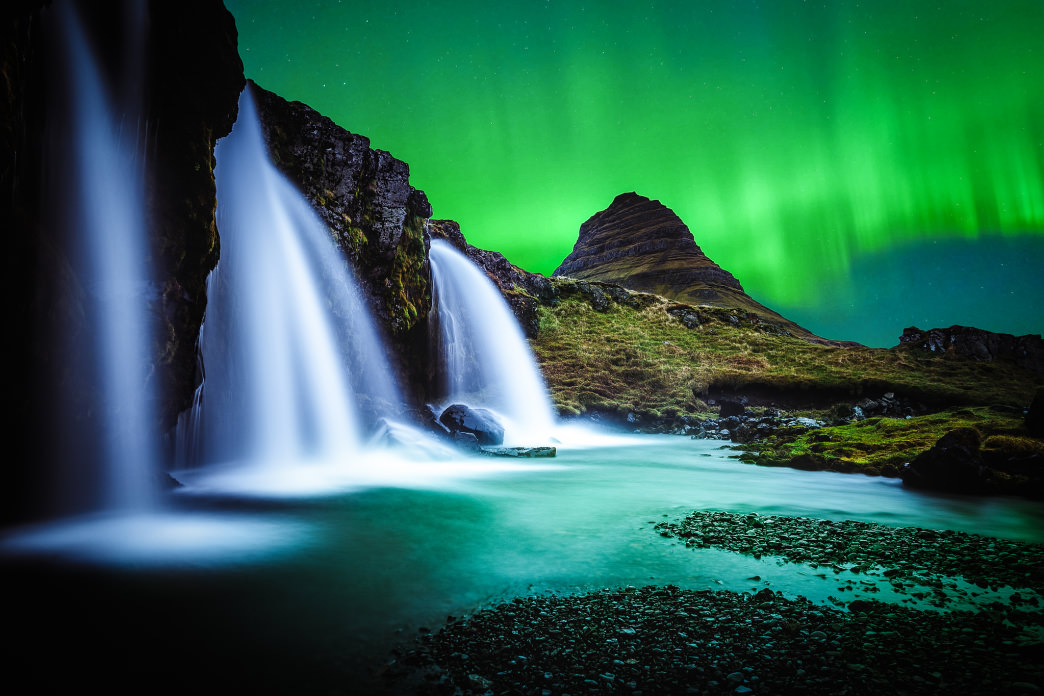Want to learn more about Icelandic culture before you fly? Discover 25 fascinating facts about Iceland from Craghoppers.
Iceland is a land of many wonders. Geothermal forces boil under the skin of the land, fierce winds howl over the North Atlantic, and glaciers trudge down the sides of volcanic mountains. But perhaps the most amazing phenomenon occurs when the aurora borealis blaze across the dark night, illuminating the snow-encrusted ground in a pale, dazzling shade of cosmic green.
No amount of recorded video can compare to the sensation of seeing the northern lights in person. Some nights, barely visible smudges in the sky phase into faint shapes, then dissolve into the blackness. But on those special evenings when they are in full effect, the heavens burn a deep green from horizon to horizon, morphing and rolling in emerald waves. The light casts shadows on the Earth below and it’s often bright enough to read a book (though how could you take your eyes off the show in the sky?)
Aurora borealis (in the northern hemisphere) and Aurora australis (southern hemisphere) are generated by the same process: The sun produces strong solar winds that send charged gaseous electrons and protons into the Earth’s atmosphere. When these solar particles react with Earthly elements, the color they emit will differ. Oxygen produces the most common hue of greenish yellow light. When particles meet at elevations of 60 to 100 miles above Earth, various glowing greens will shine. If they meet higher up, the oxygen will glow a rare red. And nitrogen gas is responsible for bluish glows (which can be particularly faint).
Iceland Provides Optimal Viewing

Because of its high latitude, low light pollution, long winter nights, and sparsely populated landscape, Iceland is one of the best places on the planet to comfortably witness the northern lights. Seeing the lights is truly a special treat because there’s no way to guarantee they will show up—but the good news is that you can stack the odds in your favor. Just make sure you bring some warm clothes!
Prime viewing season starts at the end of September and continues on until early April, though if you have your heart set on seeing the lights, November through March is best. Reykjavik, where nearly all visits to Iceland begin, never quite gets 24 hours of total darkness in winter, but it comes close. More darkness is, of course, good. During bright displays, the northern lights are visible from the city. The lights fluctuate in intensity in three- to five-day cycles most years, so it’s a good idea to make your visit at least a week long for the best chance to see the lights. Cold, clear, winter nights are perfect viewing conditions, though storms and winter fog can block the electric light show above the clouds.
Leave the City for Brighter Skies

If you want to immerse yourself in the deepest glory of the lights, getting away from the city is the way to do it. Iceland is all about adventure and one of the coolest ways to see the lights is from the warm, cozy confines of an “aurora bubble”—a clear, comfy dome made for watching the sky.
Buubble is a popular company that offer this unique lodging. Make sure to make your reservations well in advance. Pricing varies, but was under $200 USD per night as of 2016. Another novel way to see the lights is to take a boat off shore and gaze at the sky from the ocean waters. Reykjavik Sailors is an excellent company that offers these guided excursions for about $80 USD per person.
Finally, if you want to venture beyond The Reykjavik area, there are several smaller towns that are more remote. Farther north is Akureyri, the second largest city in Iceland and a fine place to see the lights right from the city. Don’t worry, it’s a thriving civilized place (with good restaurants) and the locals are happy to join in the hunt for the best viewing spots.
Other Icelandic Attractions

When not hunting the lights, Iceland in the winter months can be an explorer’s dream. Reykjavik is a lively place no matter how cold it gets, with excellent dining, fascinating museums (such as the Víkin Maritime Museum and the strange-but-true Icelandic Phallological Museum), and several popular hot spring-fed lagoons and beaches. For the more adventurous, there are volcano tours and waterfalls waiting in the countryside. However, if you happen to catch the northern lights, chances are that will be all you will talk about when you return home.
Originally written by RootsRated for Craghoppers.
Featured image provided by Andrés Nieto Porras

 The aurora borealis over Kirkjufell, Snæfellsnes, Iceland.
The aurora borealis over Kirkjufell, Snæfellsnes, Iceland.